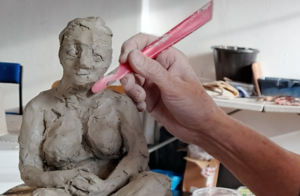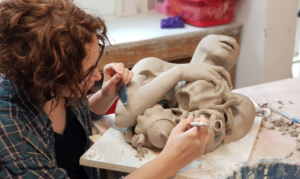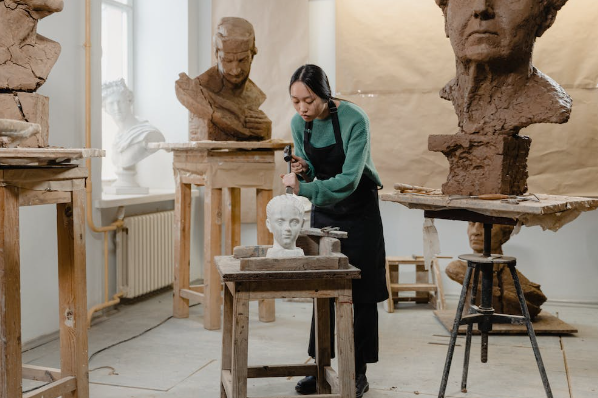Table Of Contents
- 1 Session 1: Shaping Inclusion: Adapting Clay Sculpting for Special Needs
- 1.1 Exploring the Need for Adaptation:
- 1.2 Session 2: Deconstructing Barriers: Understanding Challenges and Adapting Techniques
- 1.3 Understanding the Challenges:
- 1.4 Adapting Techniques to Foster Participation:
- 1.5 Physical limitations:
- 1.6 Sensory processing differences:
- 1.7 Cognitive impairments:
- 1.8 Session 3: Shaping Transformation: Real-life Stories of Inclusive Clay Sculpting
- 1.9 1. From Anxiety to Confidence: Sarah’s Journey:
- 1.10 2. Reshaping Perception: David’s Creative Exploration:
- 1.11 3. Reconnecting with Purpose: Mary’s Therapeutic Journey:
- 1.12 4. A Symphony of Senses: Emily’s Sensory Exploration:
- 1.13 5. Collaboration and Community:
- 1.14 Session 4: Shaping a Brighter Future: Conclusion and FAQs
- 1.15 A Legacy of Inclusion: The Power of Adapting Clay Sculpting
- 1.16 Frequently Asked Questions:
- 1.17 1. What training is needed to adapt clay sculpting activities for special needs?
- 1.18 2. What are some affordable alternatives to clay?
- 1.19 3. How can I find inclusive clay sculpting programs or workshops?
- 1.20 4. What are some tips for creating a sensory-friendly sculpting environment?
Session 1: Shaping Inclusion: Adapting Clay Sculpting for Special Needs
Introduction: Clay sculpting, with its tactile and engaging nature, has long been recognized for its therapeutic benefits and ability to spark creativity. However, for individuals with special needs, traditional clay sculpting techniques may present barriers to participation and enjoyment. Recognizing this, the field of art therapy and special education has made significant strides in developing creative adaptations that ensure everyone can experience the joy of shaping and molding clay.
Exploring the Need for Adaptation:
Individuals with special needs encompass a wide spectrum of abilities and challenges. For some, physical limitations may affect motor skills and dexterity, making manipulating clay difficult. Others may experience sensory processing differences, leading to sensitivities to the texture or smell of the material. Cognitive impairments may also present challenges in understanding instructions or following complex procedures.
Without appropriate adaptations, these barriers can leave individuals feeling excluded and unable to participate in the artistic process. However, by understanding the diverse needs and implementing creative strategies, we can open up the world of clay sculpting to everyone.
In the next session, we will delve deeper into the specific challenges faced by individuals with special needs and explore innovative adaptations to address them.

Session 2: Deconstructing Barriers: Understanding Challenges and Adapting Techniques
Understanding the Challenges:
Individuals with special needs encounter a variety of challenges when engaging with clay sculpting. These challenges can be categorized into three main areas:
Physical limitations: These may include reduced strength, limited dexterity, or difficulty with fine motor skills. Such limitations can make it difficult to manipulate the clay effectively and create desired shapes.
Sensory processing differences: Some individuals may have heightened sensitivities to touch, smell, or sound. The texture of the clay, its smell, or even the sounds of sculpting tools can be overwhelming for them, hindering their ability to focus and enjoy the activity.
Cognitive impairments: Individuals with cognitive impairments may experience difficulties with understanding instructions, following multi-step procedures, or remembering information. This can make learning new sculpting techniques and creating complex designs challenging.
Adapting Techniques to Foster Participation:
Fortunately, there are numerous ways to adapt traditional clay sculpting techniques to address these challenges. Here are some examples:
Physical limitations:
- Using lightweight clay: Air-dry clay or self-hardening clays are lighter and require less force to manipulate, making them easier for individuals with reduced hand strength.
- Offering pre-cut pieces: Providing pre-cut shapes or rolled-out clay sheets reduces the need for fine motor skills and allows individuals to focus on shaping and decorating.
- Utilizing assistive tools: Tools like rolling pins, extruders, and stamps can assist with shaping and creating textures, minimizing the need for intricate hand movements.
- Adapting sculpting surfaces: Elevated surfaces or lap trays can provide additional support for individuals with limited dexterity, making it easier to hold and manipulate the clay.
Sensory processing differences:
- Providing a variety of clay textures: Offering clay with different textures, from smooth and soft to rough and textured, allows individuals to choose materials that feel comfortable and enjoyable.
- Creating a sensory-friendly environment: Utilizing calming scents, soft music, and fidget toys can help reduce anxiety and sensory overload, creating a more comfortable experience.
- Offering alternative materials: For individuals with extreme sensitivities, exploring other materials like dough, playdough, or foam can provide a similar sculpting experience without the overwhelming sensory input.
Cognitive impairments:
- Breaking down tasks into simple steps: Providing clear and concise instructions with visual aids can help individuals understand complex procedures and follow them step-by-step.
- Focusing on open-ended exploration: Allowing individuals to explore the clay freely without specific instructions encourages creativity and avoids frustration with complex tasks.
- Incorporating tactile prompts: Using textures, objects, or prompts can guide individuals in their exploration and provide a framework for creating their own unique designs.
- Celebrating individual accomplishments: Providing encouragement and acknowledging individual progress builds confidence and motivates individuals to continue exploring their creativity.
By implementing these adaptations, we can create a truly inclusive environment where everyone, regardless of their abilities, can experience the joy and therapeutic benefits of clay sculpting.
In the next session, we will explore the transformative impact of adapted clay sculpting through real-life stories and case studies.

Session 3: Shaping Transformation: Real-life Stories of Inclusive Clay Sculpting
Beyond theoretical discussions and technical adaptations, the true power of adapting clay sculpting lies in the transformative experiences it fosters for individuals with special needs. Let’s delve into the inspiring stories of individuals who have found joy, self-expression, and therapeutic benefits through this inclusive art form:
1. From Anxiety to Confidence: Sarah’s Journey:
Sarah, a young woman with anxiety and depression, initially found clay sculpting intimidating. However, as she began to manipulate the clay, she discovered a sense of calm and control. The repetitive motions and tactile feedback helped her manage her anxiety, and the act of creating something beautiful boosted her self-esteem. She found joy in expressing herself through her sculptures, exploring emotions and experiences that were difficult to verbalize. Soon, the clay studio became her sanctuary, a space where she could connect with herself and find peace.
2. Reshaping Perception: David’s Creative Exploration:
David, a young man with Down syndrome, had always enjoyed artistic activities but struggled with the limitations of traditional materials. When introduced to adapted clay sculpting techniques, he discovered a world of creative possibilities. He thrived with the use of pre-cut shapes and assistive tools, allowing him to focus on his imagination and bring his unique vision to life. His sculptures, filled with vibrant colors and intricate textures, showcased his creativity and challenged societal perceptions of Down syndrome.
3. Reconnecting with Purpose: Mary’s Therapeutic Journey:
Mary, an older woman living with early-stage dementia, initially found it difficult to engage with activities. However, clay sculpting provided a gentle and familiar way for her to reconnect with her artistic past. The tactile experience of manipulating the clay stimulated her senses and brought back memories of her childhood spent creating. As she sculpted, she found moments of joy and a sense of purpose, rediscovering her creative spirit and connecting with others in the group sculpting sessions.
4. A Symphony of Senses: Emily’s Sensory Exploration:
Emily, a young girl with autism spectrum disorder, found traditional clay sculpting overwhelming due to the sensory overload. However, when offered alternative materials like dough and foam clay with diverse textures, she discovered a world of sensory exploration. She enjoyed the tactile sensations of the materials, the calming sounds of squishing and shaping them, and the visual delight of creating colorful and imaginative figures. This exploration of sensory experiences provided her with a safe and stimulating environment to express herself and manage her sensory sensitivities.
5. Collaboration and Community:
Beyond individual transformations, adapted clay sculpting fosters a sense of community and belonging. Group sculpting sessions provide opportunities for individuals to connect with others, share their creations, and learn from each other. This collaborative environment promotes social interaction, empathy, and understanding, creating a space where everyone feels valued and accepted.
These stories offer a glimpse into the immense potential of adapted clay sculpting. By adapting techniques and embracing inclusivity, we can empower individuals with diverse abilities to explore their creativity, express their emotions, and experience the joy of shaping their own unique narratives.
Session 4: Shaping a Brighter Future: Conclusion and FAQs
A Legacy of Inclusion: The Power of Adapting Clay Sculpting
As we conclude our exploration of adapting clay sculpting for special needs, a clear message resonates: this inclusive practice has the power to transform lives, unlock creativity, and foster a sense of belonging for everyone. By understanding the diverse needs of individuals and implementing creative adaptations, we pave the way for a world where the joy of sculpting is accessible to all.
Beyond the tangible benefits of improved motor skills, sensory stimulation, and cognitive engagement, adapted clay sculpting fosters a deeper sense of self-awareness, emotional expression, and confidence. It provides a safe space for individuals to explore their inner worlds and connect with others in a meaningful way.
Frequently Asked Questions:
1. What training is needed to adapt clay sculpting activities for special needs?
While formal training in art therapy or special education is beneficial, there are numerous online resources and workshops available to learn about adapted techniques. Additionally, collaborating with occupational therapists or other specialists can be invaluable in tailoring the experience to individual needs.
2. What are some affordable alternatives to clay?
Air-dry clay, self-hardening clay, and dough are readily available and cost-effective options. Playdough, foam clay, and recycled materials like cardboard and paper can also be explored for sensory exploration.
3. How can I find inclusive clay sculpting programs or workshops?
Many community centers, art studios, and therapy centers offer adapted clay sculpting programs. You can search online or contact local organizations specializing in disability services for recommendations.
4. What are some tips for creating a sensory-friendly sculpting environment?
- Provide a calm and quiet space with minimal distractions.
- Offer a variety of textures and materials to cater to individual sensitivities.
- Use calming music or aromatherapy to create a relaxing atmosphere.
- Allow individuals to explore and experiment at their own pace.
5. How can I support the development of inclusive clay sculpting programs?
- Spread awareness about the benefits of adapted clay sculpting.
- Advocate for funding and resources to support inclusive programs.
- Volunteer your time and skills to assist with program development.
By embracing inclusivity and exploring the diverse possibilities of adapted clay sculpting, we can ensure that everyone has the opportunity to shape their creativity, connect with their inner selves, and experience the joy of creating something truly unique.
Together, we can shape a brighter future where the world of clay sculpting is open to all, fostering a community of creativity, inclusivity, and empowerment.
